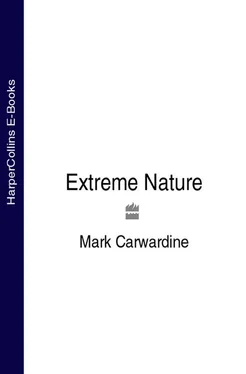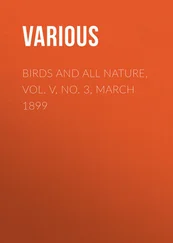In fact, this most poisonous of frogs is possibly the most poisonous animal in the world. The toxin is in its skin – you can die even by touching it – and there is enough in the skin of one animal to kill up to 100 people. Though the frog has been known to science only since 1978, inhabiting just one area in Colombia, the Chocó indians have known about it for generations, using its skin-gland secretions to poison their blowgun darts and kill animals in seconds.
The golden poison-dart frog gets most of its batrachotoxin (meaning frog poison) from other animals, probably small beetles, which in turn get it from plant sources. Captive-bred frogs, by comparison, never become toxic, presumably because they aren’t fed toxic insects. The frog is active in the day, having few predators except a snake, that has become immune to the toxin. Surprisingly, birds have been discovered in New Guinea with the same batrachotoxin in their skin and feathers. The likely link has been tracked down to a small beetle, similar to the New World beetles, which also contains batrachotoxins.
Most ingenious tool-maker
| NAME |
New Caledonian crow Corvus moneduloides |
| LOCATION |
Pacific island of New Caledonia |
| ABILITY |
thinking up ways to get at hard-to-reach food |

© Ron Toft
Quite a few non-human animals, from sea otters to woodpecker finches, use tools and sometimes even craft them. It’s usually assumed that the animal that is best at this is our nearest relative, the chimpanzee. Chimps use rocks to crack nuts and cut and fashion twigs or blades of grass to fish in mounds for termites. These are ‘cultural’ skills, practised only by certain groups of chimps and taught to youngsters. The skills are certainly sophisticated: an anthropologist once spent several months with a group of chimps trying to learn the art of termite fishing and finally achieved the proficiency, he reckoned, of a four-year-old chimp novice.
For pure innate, instant ingenuity, though, it would be hard to top the New Caledonian crow. In an experiment in a lab, meat was put in a little basket at the bottom of a perspex cylinder – and a female crow, Betty, was given a straight piece of wire. Holding the wire in her beak, she tried to pull the basket up, and failed. Then she took the wire to the side of the box holding the cylinder, poked it behind some tape and bent the end into a hook. She went back, hooked the basket, and got the meat. When the experiment was repeated, Betty did roughly the same thing, but with the addition of two different tool-making techniques. In the wild, New Caledonia crows make food-hooks out of twigs, by snipping off all but one protuberance. But bending a piece of wire … how would a crow know?
Most gruesome partnership
| NAME |
luminescent bacteria Photorhabdus luminescens meets nematode Heterorhabditis bacteriophora |
| LOCATION |
inside a caterpillar or maggot |
| ABILITY |
combining forces to eat larvae alive |
© Randy Gaugler
This is a slow and horrible way to die. A worm-like creature, a nematode, goes on the hunt by squirming through the soil in search of an unsuspecting insect grub, or larva. It’s not particularly fussy and likes anything from a weevil to a fly maggot, but it may take months to find a suitable victim. When it does, it penetrates the cuticle of the larva, either through an opening such as a breathing pore or by hacking a hole with its special ‘tooth’. Once inside, it sets free more than a hundred bacteria from inside its gut, which start producing deadly toxins, digestive enzymes and antibiotics.
The bacteria are luminescent, and as they multiply, the grub takes on a deathly glow. The nematode then starts feeding on the bacteria and the remains of the grub corpse, which is kept free from other competing microorganisms by the antibiotics. Finally, it changes into a hermaphrodite female, laying eggs in the cadaver that hatch into both male and female nematodes.
Yet more of her eggs develop inside her, and when they hatch, the juvenile nematodes eat their mother. They then mate and produce their own eggs. It’s at this point, two weeks later, that the grub finally breaks up and thousands of young nematodes (each carrying the bacteria in their guts) exit into the soil. The bacteria and the nematode can’t exist without each other – a gruesome partnership but one that humans have joined, helping the little nematodes spread by deliberately releasing them to hunt down garden pests.
| NAME |
great hammerhead Sphyrna mokarran |
| LOCATION |
tropical and warm temperate seas |
| SKILL |
hunting with electricity |
© James D Watt/imagequest3d.com
All sharks can, to some extent, detect other creatures by sensing the minuscule amount of electricity they create simply by virtue of being alive. In most sharks, this sense is principally an adjunct to more dominant senses (usually hearing, smell and vision) and is particularly important in the final split-second of an attack. But for hammerheads, it’s the main thing, and it could be one reason why their heads are shaped in the curious way they are.
Sharks have special electrical receptors – hundreds of tiny, dark pores called ‘ampullae of Lorenzini’ – which are filled with a conductive gel that transfers electrical impulses to a nerve end in each pore. Ordinary sharks have these all over the snout and lower jaw, forming a curious pattern of dark holes resembling a sparse five-o’clock shadow.
But hammerheads also have a mass of them across the underside of their oblong heads, which scan across the sandy sea-bottom like metal detectors, searching for prey animals that can’t be found in any other way – creatures such as stingrays and flatfish that bury themselves, lie still and usually have no appreciable scent.
The hammerheads are able to detect the slight direct currents caused by interaction between the bodies of their prey and the seawater and the even slighter alternating currents caused by muscle contractions around an animal’s heart. The eight species of hammerhead can sense it better than most other sharks, and the biggest of these, the great hammerhead, which measures up to 6m (20ft) long, may be able to sense it best of all.
| NAME |
holy-cross, crucifixor Catholic toad Notaden bennetti |
| LOCATION |
Australia |
| ABILITY |
producing a super ‘superglue’ |

© Ken Griffiths/ANTphoto.com
Some of the world’s strangest creatures are found in Australia – a continent of extremes giving rise to extreme adaptations. The holy-cross toad lives where many other amphibians can’t: in hot, harsh areas inland, where droughts may last for several years. It uses its strong back legs to burrow down in the soil, where it sits out the heat of the day, and when drought sets in, it survives by digging a chamber a metre or so underground in which it aestivates (becomes dormant), emerging only when the rains return.
Читать дальше












![Various - Birds and Nature Vol. 11 No. 3 [March 1902]](/books/745532/various-birds-and-nature-vol-11-no-3-march-1902-thumb.webp)
![Various - Birds and Nature Vol. 9 No. 3 [March 1901]](/books/745788/various-birds-and-nature-vol-9-no-3-march-1901-thumb.webp)